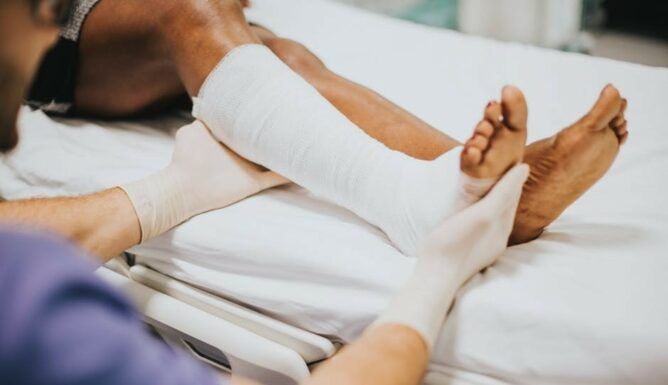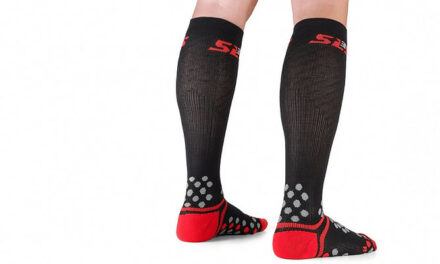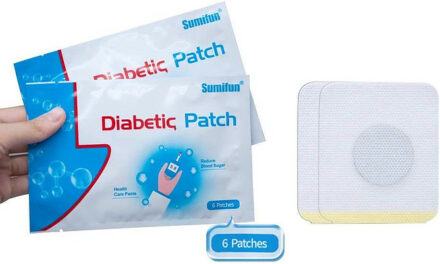The process of diabetic wound healing, like in any other wound, involves a sequence of cascade actions carried out by the immune system, blood clotting factors and cells division within and surrounding the wound.
Firstly, let’s look at how the wound healing process looks like.
Types of wounds
There are five types of wounds, they are:
- Wounds caused by deficiencies of the vessels or blood supply (arterial, venous or mixed)
- Neuropathic wounds – these are the ones common among people with diabetes
- Skin conditions called ‘dermatitis’ caused by moisture
- Wounds following skin tears
- Pressure ulcers
In this article, we are looking at neuropathic wounds and ulcers, which is an interest to people with diabetes.
Diabetic Wound Healing Process
Following any wound, let’s say when a cut occurs in the body, the blood clotting factors present in the blood along with the collagen and the dermal proteins block the bleeding. They form a sturdy barricade.
Later the inflammation process begins. The fibroblasts, macrophages and chemokines, platelets, immunoglobulins, white blood cells tackle the infections and foreign bodies. This leaves the area swollen, redness, and if not cared well might lead to pus formations.
The infections and bacteria are squeezed out, and the cells divide, pulling the tissues tight from within. The skin/dermal tissues are fast dividing with their collagen and fat cells depositions.
As the days pass, the wound site scars and the wound go off, leaving no traces.
But as we know, diabetes hinders the healing as it affects all the areas that work in the wound healing process. For example, diabetes affects the immune system, nervous system, thickens blood vessels, and lowers blood circulation.
Finally, as a collective outcome, the delayed wound healing is an inevitable result most people with diabetes experiencing.
The wounds are grouped by various classifications put forth into grades. All of those primarily divide wounds based on the line of infection, and the depth or severity of wounds.
In the collection, doctors decide how much the complex the wound is and the likelihood of reversing it.
Diabetic Ulcer Staging and Classification
Wagner- Meggitt classification
Wagner- Meggitt classification is used commonly in staging diabetes foot ulcers.
Wagner- Meggitt classification graded wounds from the superficial skin wounds to the extremes of gangrenous wounds as grade 0 to grade 5. Such wounds include ulcers, bone ulcers including osteomyelitis, and gangrenes.
Grade 0 – The wound is completely healed with a cover of skin ‘epithelial’ layer
Grade 1 – Wound yet to heal fully. Ulcer thickness is limited to superficial ‘demis’ skin layer
Grade 2 – Ulcer is exposed to the tendons or bones. However, yet no signs of bone infections (osteomyelitis) or abscess.
Grade 3 – Deep ulcers, beyond Grade 2 now with abscesses and bone infection.
Grade 4 – Gangrene on the foot or toes limited to one location only
Grade 5 – Gangrene has spread in the foot.
PEDIS Classification
PEDIS Classification assesses Perfusion, Extent, Depth of infection, Infection and Sensation (PEDIS) of a diabetic foot ulcer in giving a score to stage the severity of such diabetes ulcer.
Perfusion
In this context, Perfusion means arterial blood supply to the wound, which is an important factor of the wound healing process. Based on the severity of ‘ischemia’, death of skin tissue due to poor or lack of blood supply, the score gives 1 or 2 points.
No critical limb ischemia +1
With critical limb ischemia +2
Extent
In this context, the Extent means the area of the skin is affected by the wound. Based on wound size, the score allows 1 to 3 points.
Area less than 1 sq cm +1
An area between 1 and 3 sq cm +2
An area over 3 sq cm +3
Depth
In the PEDIS Classification, Depth means who deep is the wound. Based on the depth, 1 to 3 points are given as follows.
Superficial wound +1
Wound extend to fascia, muscles or tendons +2
Wounds extend to bones or joints +3
Infection
Based on the severity of underlying infection, the PEDIS Classification allows 1 to 3 points as follows
Infection only in the surface of the wound +1
An infection causing an abscess, fasciitis or severe arthritis (septic arthritis) +2
The body is affected with systemic inflammation, for example, infection is in the blood (known as septicemia) +3
Sensation
In this value, if you are experiencing sensation, for example, pain that is a good thing. In that case, you receive only a 0 point. If no sensation, 1 point is given.
Remember, in the combination of the above five values for Perfusion, Extent, Depth, Infection and Sensation is over 7, the score suggests that the patient has a ‘high risk’ for amputation.
In other words, the score shows possible complication stages if the diabetes wounds were ignored, and the importance of maintaining a low score of less than 3 combination score.
Texas System Of Diabetes Foot Ulcer Classification
The University of Texas diabetic ulcer staging system has four grades, Grade 0 to Grade 3 and four stages, Stage A to Stage D.
The system considers the severity of ulcer penetration (its depth from superficial skin), presence of infection, and the presence of poor blood flow (ischemic wounds) when assessing the clinical picture of the wound.
A Simple Classification For You
After all, it’s best to remember, the possibly the most straightforward classification for people with diabetes is to remember would be the below.
Diabetes wound or ulcer with a mild infection
Diabetes wound or ulcer with a moderate infection
Diabetes wound or ulcer with a severe infection
Remember, if you don’t control well the infection while it is ‘mild’, eventually it will turn out to be a ‘severe’ one.
Why Does Diabetes Cause Delayed Wound Healing?
Diabetes as dreadful as its nature stunts the wound healing process due to a list of reasons.
High blood glucose levels stagger your body’s ability to heal the wounds and injuries. The blood vessels are affected by the sugar levels, which can’t let the oxygen, nutrients and increased blood flow to the wounded areas, hindering the healing.
Diabetic foot, ulcers or just that is caused in neuropathy diabetics are hard to diagnose or detect because of already existing numbness. It makes the repairing nature of the cells ineffective, eventually spreading the infection.
A neglected wound in diabetes may end up in necrosis (dead skin) and gangrene, which are extreme conditions of delayed wound healing.
Infection that arises along with the open cuts and wounds spreads into the surrounding areas when not healed properly.
Diabetes also hammers the immune system drastically, along with the nervous system. Hence, the immunoglobulins, platelets, white blood cells and factors can’t fight the risks brought by the wounds.
The deficiencies of zinc or iron in anemia and Vitamin B family delays the wound healing as the even the production of blood clotting factors needs them.
As you understand now, diabetes stands against your recovery process and in the battle of wound healing.
How To Prevent Diabetic Wounds
Diabetic wounds pose a high risk of amputations caused by delay in wound healing and necrosis. This happens as the circulation of blood to the wound areas, and numbness in the wounds increases infection, which ends up sore consequences.
Preventing diabetic wounds involves a self-hygiene on the major prospect. But, not only that your lifestyle broadly plays a significant role too.
Let’s look into details.
Smoking and drinking
You need to quit the drink and puff habits. They contribute to the worsening of the wounds by restricting the sense of infected areas and inhibiting blood flow.
We have discussed the effects on them more extensively in the article, Home Remedies for Type 2 Diabetes.
Footwear
A wrong pair of shoe exaggerates your risks of diabetes ulcers. The tight and suffocated areas of the foot are more likely to develop ulcers, rashes and swollen feet.
Podiatrist prescribed pair of shoe with consoling cushion and sole are effective for people with diabetes.
Did you know how to select Best Footwear to Prevent Diabetes Foot Ulcers? Just follow the link to read more.
Cleaning
Regular wash, a foot soak with Epsom salts, cleansing with mild soaps and lukewarm water, keeping them dry always should be done.
Cleansing should not be rash.
Warm baths are helpful in the cleaning as well as to sooth any leg pains, as noted previously in the article Diabetes Leg Pain Relief.
Checking feet
Keep an eye on the blisters ulcers, sores, cuts and fissures that arise unpredictably.
Trimming your toe and fingernails, preventing debris and dirt accumulation is important.
Lotion should be applied to avoid the dryness of the foot.
And, most importantly, do not walk barefoot.
Exercise
Given all the risk of acquiring wounds, in your journey, exercise is extremely important in managing diabetes well.
Do not go slow or stagnant with your limbs. Keep their metabolism high by a stroll and regular walking. Exercise with low impact workouts and stay away from the draining sweat always.
A complete list of Best Exercisers for Diabetic Patients is a click away.
How To Care For Diabetic Wounds
For any kind of a wound to heal, proper wound care is an absolute requisite. Adequate wound care treats the wound fast, erodes the infections and deterioration of the tissue.
Cleaning
A cut, blister, ulcer, bruise and a wound everything should be cleaned with a mild soap or clean water and clean hands immediately, thoroughly and regularly.
Cleaning keeps away from the invasion of dirt, bacteria and other foreign organisms.
Applications
Use antiseptics, disinfectants, antimicrobials in the form of lotions and creams on the wounds. This blocks the spreading of infections and kills persisting bacteria.
Instead of talcum or any other powders, use the antiseptic powder or cream prescribed by your doctor or pharmacist.
Bandages
Bandages of various kinds from the antimicrobial bandages (dressings) to the easy to stick first aid bandages are available in the pharmacies.
Depending on the depth of the wound, primary and secondary dressings can be chosen.
Great wound care in diabetic wounds suppresses the infection, which accelerates the healing process.
Regular dressings provide adequate antiseptics, antibiotics and oxygen facilitation. It helps to remove any pus and discharges, keeping the wound and the surrounding clean.
The tightened bandages increase the homeostasis and blood clotting. However, bandages (dressings) are not recommended for all wounds.
Remember, a neglected wound leads to amputations, spreading of infections even to the circulation and neighboring areas of the wound.
Longer you ignore the healing efficiency is highly collapsed and compromised.
Treatments
Treatment options for diabetic wounds are vast, from traditional methods to advanced procedures are available.
Antibiotics and antimicrobials are given orally and for topical applications. At later stages, antibiotics over intravenous (IV) line may be needed.
Stem cell treatments are advanced procedures in healing; however, with no direct evidence for their effectiveness. Non-surgical stem cell treatments believed to alleviate the pain. Regenerative stem cell treatment could enhance tissue regeneration.
Neuropathy foot is tested by mono filament.
Necrosis, gangrenous tissues are treated by surgeries, removing the necrotising tissues and read gangrenes, skin grafting.
Some people with complex diabetes wounds prefer hyperbaric oxygen therapies that use oxygen to produce the collagen and strengthen the immune system.
Amputations are suggested at the worst scale of the disease.
Tips For Healing Diabetic Wounds Fast
Diabetes always works on its way to struggle the body in all the possible ways. We all know how nasty diabetes can be.
Here are some tips to speed up the diabetic wound healing process.
Monitor Your Blood Sugar Level Often
Follow the link to learn Everything about Diabetes Blood Sugar Monitoring and Testing.
Nerve Health and Immunity
Neuropathy caused by diabetes may affect your nervous system and body functions. The immune system and the actions of various cells are inhibited by the rising and lowering blood glucose levels in the body.
As such, focusing on improving your nerves and immune health becomes equally important as you maintain your sugar levels closer to normal range.
Healthy Diet
A healthy diet that gives the abundant protein and fiber, but low in calories and carbs is essential to accelerate the wound healings.
Your dietitian can advise on a balanced diet tailored for you.
Make sure you know the facts about foods and do not catch up with Diabetic Food Myths.
Cleansing with Honey
Raw honey has a promising role for making your healing fast with its cell divisions and tissue growth enhancing anti-inflammatory properties. Its action, by far has been proved with significant results.
Cleanse the wound, apply the raw honey and dress it. It gives effective results with regular use.
Aloe Vera
Aloe Vera with anti-inflammatory and healing properties, turmeric with an abundance of antiseptic cur cumin triggers the healing process greatly.
Relaxing massage
A regular massage with extra virgin olive oil and coconut oils heals, moisture and enhances blood supply.
And, not to forget, to read and try the Foot and Calf Massager, and Infrared Heating Treatment options MediChannel presented to you earlier.
Do’s and Don’ts for People with Diabetic Wounds
A checklist of the dos and donts for a person with diabetes is always useful as a guide to making sure you take proper care of your health.
Knowing a little and not knowing a lot, may end up making you still prone to many complexities, especially in case of diabetes wounds.
Things To Do (Do’s) As A Diabetic Patient
Regular Checks
- Check your feet regularly for abscesses, open cuts, sores, blisters, redness, in toe growths, swelling/edema. Do it daily, if not at least weekly.
- Never underestimate an open wound or cut, a bleeding, and delayed clotting. They may free deadlier to cause even amputations.
Blood Glucose Monitoring
- Not only the checks of your legs, but regular Blood Glucose Monitoring is also important.
Doctors for Diabetes Ulcers
- Learn How To Choose The Best Doctors To Treat Diabetes. Make sure to include a Podiatrist, Orthopedics and Skin Specialist in your care team.
- Visit the Podiatrist regularly.
- Be in touch always with your doctors, get your regular regimes done, tingling, bruises, numbness, fungal infections, skin diseases, etc. are nothing to be ignored about.
- And, if required, depending on the severity of your wounds and ulcers, not to forget to visit a Vascular Surgeon too, regularly.
Moisturizing
- When your leg is ulcer free, apply lotion and keep your feet rejuvenated. Moisturizers prevent dryness and itching, cracking of feet and scaling of the skin. Remember, the lotion must not be applied in between the toes with infection as they exaggerate it.
Exercise and Massage
- Stretch and squeeze your ankles and feet with moderate exercise for a little span repeatedly. This ensures the extremities are supplied with a nutrition rich blood flow that prevents numbness. Unimpactful exercises
are always good for the body.
- This is where Foot and Calf Massagers and Infrared Heating Treatment options play an important role.
Hygiene
- Maintain dirt and infection free limbs. Trim, clean and moisture the feet. Deposits of bacteria, sweat, and dirt welcome infections and ulcers; an open cut is more prone.
- Wearables to feet like shoes, socks, and slip-on should be washed thoroughly and contamination free. Any persisting viruses in them may worsen the situation. Sterilized methods of washing also help.
- Give a mild soap wash, and Epsom water soaks to the feet.
Diet
- Maintain your diabetic plan given by the dietitian strictly. It grips your control over the blood sugar levels, which are vital in the wound healing process.
- Keep hydrated, drink lots of water and stipulated juices. Though medication and food meal plans are preset, the hydration pulls up the low blood pressures.
Follow the link for more details of Type 2 Diabetes Diet and Foods.
Things Not To Do (Don’ts) As A Diabetic Patient
Knowing the don’ts are equally important, so as not to be ignored.
Be Gentle
- Don’t go too rash on your numbed limbs. You may not feel the sensation in the area, but applying hot pads, packs or pouring hot water may adversely affect the skin.
- Don’t go with your hands on any of the wounds, cuts, bruises. Don’t try to self treat or scare off any calluses, hard tips or the open cuts manually.
- Do not soak your feet in too hot or too cold exposures. Maintain warmth and dryness with comfy clothes.
Always Cover With Footwear
Do not go barefoot either when you have a diabetic foot or even when it’s healthy with no wounds. Barefoot can easily attract a range of bacteria.
Do not use footwear and clothing’s, that presses your skin tightly, or that suffocates your pores. This develops redness, rashes, and ulcers.
Your Diet
Don’t cheat on your diet. This worsens the necrosis, gangrene, infections, and ulcers. Sugars, carbs imbalance adds to your situation.
Don’t neglect the medications, dressings and check your insulin dosages, antibiotics.
When to see your doctor
A diabetic wound or ulcer is that health issue which can’t be solved by only self-care. Diagnosis and medical observation would be necessary to barricade further complications of diabetes.
Diabetic patients may need a doctor, your Family Doctor or General Practitioner (GP), for every minor change in their body.
Remember, the neuropathic foot is traditionally checked by a podiatrist and perform mono filament, which is a painless procedure. So, if you are diagnosed with a ‘neuropathic foot’ regular visits to the Podiatrist is a must.
Some of the alarming signs indicating that you need to arrange a visit soon to your Family Doctor are below.
- Numbness in the foot and hands, which means they do not show any or less sensation of pain, touch, tear, and prick.
- Unexpected cuts and wounds and they are mostly less sensitive (less pain than what you anticipated).
- Unstoppable bleeding in case of open wounds.
- Delayed blood clotting, possibly due to the inefficiency of the blood clotting factors cascade mechanism.
- Delay in the healing process due to blood sugar levels, and possibly due to immune system failure along with the nervous system.
- Lack of sensation due to reduced blood flow to the extreme parts of the body as diabetes thickens the diameter of the blood vessels.
- Redness, and dryness of the skin.
- Open wounds, cuts that are resistant to the healing with open ends.
- Inflammation and pus formations, other discharges in the wounds due to the infections.
- Bruise s, blisters, sores and fissures in the limbs.
- Unyielding infections and necrotising soft tissues, open and spreading necrosis.
- Intensified foot pains.
- Abscesses.
- Discharge from the wound.
- Dead skin and gangrene tissue.
- Skin discoloration and skin dryness, which you have not experienced before.
- After a doctor cleans and dresses the open wounds, tackles the infections, and removes the dead tissues of gangrene.
- When your tetanus vaccine has been expired a long while ago, as this makes you prone to septic infections.
- Following removal of dead skin (debridement and scalings) you notice signs of infections, they should be attended your doctor.
Also, antibiotics and cleanings set for appointment are not to be skipped. And, nursing and treatments prescribed should not be neglected.









Hey Shani, Thanks a lot for this informative post.
As a large group of people including my brother suffering from Diabetic wounds, Diabetes wound or ulcer with a mild infection, I lately read more about it and obtaining more information In conjunction with this disease.
Then, I came across your detailed and well-written article. It certainly could benefits the readers and I personally glad to find out useful information through your article as well. I suppose there is no question unanswered in your post.
Thank You and warm regards.
Hi Shani
This is a great post, very detailed and informative.
I have seen diabetic people being amputated but I always assumed it was because of the disease, can diabetes cause a wound? Now, after reading your post, I get the sense that a common wound can be complicated to heal for a diabetic person.
I am very glad to know how to care about a wound for a diabetic person. My mother has been diagnosed with diabetes, so I am trying to learn everything I can on the subject.
Thanks for sharing.
Dear Adyns,
Thanks for the comment, and I am glad you found the article useful.
Diabetes would not cause wounds; however, people with diabetes are prone to wounds and injuries due to any associated diseases of blood vessels (e.g. varicose veins) and nerves (e.g. neuropathy). Top of that, the main challenge is the slow wound healing process, as I have gone into detail in the article.
Hope this helps. Do not hesitate to Contact Us with any questions you may have.
Kind regards.
For Grade 4 and Grade 5, I’d like to ask if there are still hopes of these kind of wounds so we won’t resort to amputation? Like for example, with special nutrition therapy where the person would supply his body with nutrients that are known healing and correcting the body, do you think we still can avert amputation by encouraging rejuvenation on the affected area?
Hi Gomer,
As an expert in diabetic wound care and treatment, I understand your concern regarding Grade 4 and Grade 5 wounds and the possibility of avoiding amputation. It’s crucial to note that Grade 4 and Grade 5 wounds are severe and present significant challenges in the healing process due to the depth and extent of tissue damage. However, while the road to healing may be difficult, there are still potential treatment approaches that may help in avoiding amputation or promoting wound healing:
1. Advanced Wound Care Techniques: Utilizing advanced wound care techniques, such as negative pressure wound therapy (NPWT), wound dressings with growth factors or antimicrobial properties, and bioengineered skin substitutes, may support the wound healing process for complex wounds.
2. Offloading and Pressure Redistribution: For wounds on the feet or lower extremities, offloading and pressure redistribution techniques, such as using specialized footwear or orthotic devices, can help relieve pressure on the wound site and promote healing.
3. Hyperbaric Oxygen Therapy: In some cases, hyperbaric oxygen therapy may be considered as a treatment option. This therapy involves breathing pure oxygen in a pressurized room or chamber, which can improve oxygen delivery to the wound site and potentially promote healing.
4. Optimal Diabetes Management: Proper management of diabetes, including controlling blood glucose levels, is essential for supporting the body’s healing processes and preventing further complications.
5. Special Nutrition Therapy: Nutritional support plays a vital role in wound healing and tissue repair. A diet rich in protein, vitamins (e.g., vitamin C, vitamin A), and minerals (e.g., zinc) can aid the body’s ability to regenerate and repair tissues.
6. Consulting a Wound Care Specialist: Seeking guidance from a wound care specialist or a multidisciplinary wound care team can be beneficial. They can assess the wound’s severity, determine the most appropriate treatment plan, and monitor progress closely.
It’s important to recognize that the success of wound healing and the potential to avoid amputation in severe cases can vary from person to person. Factors such as the individual’s overall health, the specific wound characteristics, and their responsiveness to treatment all play significant roles.
Early intervention and consistent wound care are crucial for the best possible outcome. If you or someone you know is dealing with diabetic wounds, it is vital to seek professional medical attention promptly. Delaying treatment can increase the risk of complications and further tissue damage.
Remember that wound healing is a complex process, and individual outcomes may differ. Working closely with healthcare professionals to develop a personalized treatment plan can maximize the chances of successful wound healing and prevent the need for amputation whenever possible.
Please note that the information provided here is not a substitute for professional medical advice. If you have specific concerns about diabetic wound care and treatment, it is best to consult with a qualified healthcare professional for personalized guidance and care.
Take care!